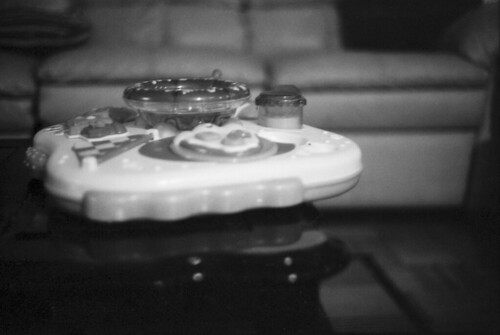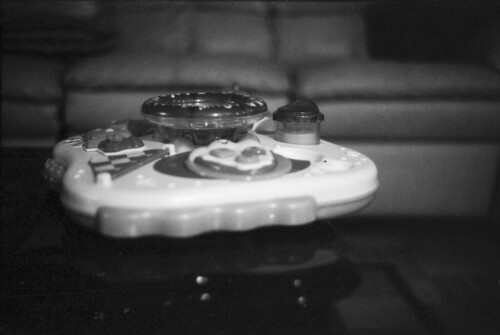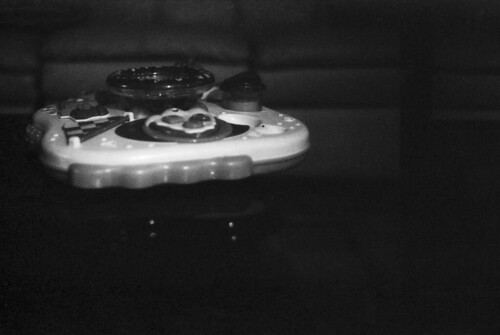I loaned out my Pentax Spotmatic to my mom, as she asked me to teach her how to use her dSLR. What good is teaching how to use a camera that does most of the thinking for you? I wanted her to understand the relationship of the film speed, shutter speed, and aperture opening, and how it relates to the final image before teaching her how to use her dSLR.
The best way I could teach her, at least I figure how I could teach her, would be by taking a mostly mechanical camera that has a TTL meter, and get her to understand how each setting affects the final image, and why it does what it does.
Looking at a dSLR that can pretty much do all the thinking for you is a bit, well, wasted I think. Sure, I like how you can just point, and shoot, and get the image you were wanting, err, except you will probably sit there and fire off 10 or 15 frames to get that one image, then move on to the next.
Using a film camera where every frame counts will get you to slow down and think a bit more when shooting.
When I loaned out the camera I thought I had loaded it with 400ASA Fujifilm Superia film. Sure enough, when the roll was complete, it was actually loaded with Polypan F 50, which was going to require a 3 stop push to get usable results. Time for some experimentation.
As I hadn't pushed Polypan like that in a while, there was some time experimentation to try and figure out, so I reached out my Konica Auto S2 and loaded it up with a roll of Polypan F.
Picking up my dSLR (Canon EOS 40D) and metering off of a single object to get a baseline for exposing the film, I took a few frames with the Konica at 400ASA. Well, after shooting a half-dozen frames at 400ASA, I turned it up a notch, and shot a few frames at 800, then a few more at 1600.
After unloading the camera in a dark room and loading up a single-reel tank for testing, I reached out my Diafine and gave it a 5+5 minute soak in the baths. Reading Larry Dressler's big write-up on the BlackandWhiteology forum about Diafine, plus also reading what else has been written about Diafine, such as exposing the same roll at multiple different EIs and developing without having to adjust your times. Usually I develop Polypan F at 3+4 in Diafine with excellent results, especially when exposed at 80ASA, only this time I went with the 5+5 to try to get the most out of the developer.
Sure enough, at 400ASA the film holds together nicely, giving a fine grain, considering, good shadow detail, and good highlight detail. The negatives are a little thin, but that is to be expected, all things considered. Perhaps I'll have to give it a try in Rodinal 1+50 and see how that works out at 400ASA.
When it's exposed at 800ASA I found that the negative was much thinner, losing more shadow detail then highlights, but over-all, still manageable. Not the best film to give a 4 stop push, but it does work at 800. In a pinch, if you need to shoot at 800ASA, then you can get some decent results over-all. Personally I would suggest using a 400 speed film and giving it a 1 stop, but if you only have Polypan on you, then you can get away with 800.
Lastly, it leaves me with the final push at 5 stops, and 1600ASA. This was the most brutal push I have ever tried with this film, and really wasn't expecting anything short of a disaster. The grain is pronounced, the negatives are quite thin, and the shadows block up a fair bit. The highlights are still quite strong, retaining detail in them, as expected with a push, but there is little, if any, detail in the shadows. It's quite amazing the difference from 800 to 1600ASA makes. The image is truly losing out in detail, but the fact that it actually did work is quite remarkable.
So in conclusion I didn't actually use DIAFINE to push my film at all, but see that it works very well for shooting at 400 and even 800 with Polypan. I decided on trying TMAX 1+9 for 37 minutes instead, which still resulted in some thin negatives, but they are usable. Not sure how pronounced the grain is, but will be scanning them in the near future.
The next test will be done under better light conditions for pushing the film, and trying 5+9 in Diafine instead, that is, of course, if it'll make any hint of difference.
Until next time....
Keep those Shutters Firing!



No comments:
Post a Comment